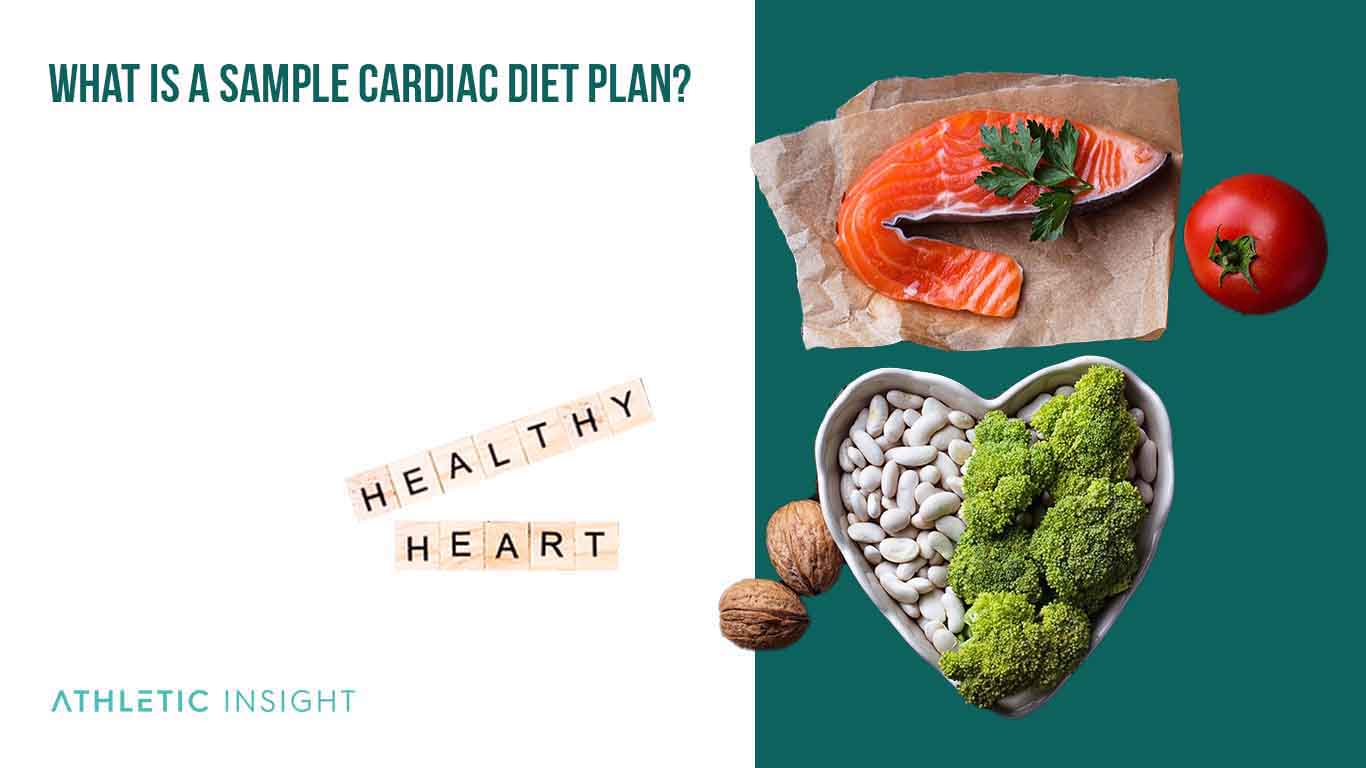The cardiac diet is important for the cardiovascular system since it includes heart-healthy foods. The cardiac diet food list includes whole grains, vegetables, fruits, lean poultry, salmon, and other fish high in omega-3 fatty acids.
The benefits of the cardiac health diet include its flexibility and the many food options available. While you need to limit the amount of added salt and sugar, you can eat any fruit or vegetable when following a cardiac diet plan.
Cardiac diet guidelines include several types, such as the Mediterranean diet, the DASH diet, vegan and vegetarian diets, the flexitarian diet, and low-carb diets. The vegan and vegetarian diets eliminate all meat products while the other diets allow lean poultry and limit red meat.
What Is a Cardiac Diet?
So, what is a cardiac diet, and what types of foods are allowed on the cardiac diet menu? The most important aspect of the low sodium cardiac diet is its health benefits for the heart. The foods allowed when following a heart-healthy diet are whole grains, seafood, lean meats, all fruits and vegetables, and fat-free or low-fat dairy products.

How Does the Cardiac Diet Work?
The cardiac diet meal plan focuses on minimizing sodium intake and consumption of unhealthy fats, such as those found in fatty red meats or processed meats. This diet particularly focuses on improving heart health. The lack of sodium intake means the human body will experience lower blood pressure and a lower risk of hypertension.
Therefore, those on the diet are less likely to experience heart attacks and cardiovascular issues. A low-fat diet will also reduce plaque build-up in the arteries.
What Are the Health Benefits of the Cardiac Diet?
You can read more about the biggest health benefits of the cardiac diet menu plan in the list below.

- It improves heart health
- The diet reduces the risk of heart attacks
- It reduces blood pressure and cuts the risk of hypertension
- It lowers bad cholesterol known as LDL
- It improves good cholesterol called HDL
- The diet helps with weight management
- The diet may reduce cancer risk
Cardiac diet foods also play a role in cutting plaque build-up in the artery walls throughout the human body. You can also use the cardiac diet for weight loss. These are the top health benefits of the diet.
What Are the Health Risks of the Cardiac Diet?
You’ll find the biggest health risks in the 3-day cardiac diet. The biggest issue is the potential dangerous impact on the human body due to its restrictive nature and unsustainability. The 3-day cardiac diet menu has very little research supporting it, and it removes many heart-healthy foods from consumption.
On the other hand, it allows you to eat ice cream in large amounts, diet soda, and white bread. These foods are all linked with negative cardiovascular issues.
What Is a Sample Cardiac Diet Plan?
A cardiac diet plan may contain some of the following options for breakfast, lunch, and dinner throughout the typical week.

Monday
- Breakfast: Oatmeal with walnuts, a banana, and skim milk
- Lunch: Low-fat yogurt, a cup of canned peaches, whole grain crackers with guacamole, broccoli, and cauliflower
- Dinner: salmon with green beans, salad greens, sunflower seeds, almonds, low-fat salad dressing, skim milk, and one orange
Tuesday
- Breakfast: low-fat yogurt with blueberries and orange juice
- Lunch: whole-wheat pita with lettuce, tomatoes, cucumbers, feta cheese, and low-fat dressing, one kiwi, and a cup of skim milk
- Dinner: chicken stir-fry with eggplant and basil, brown rice with dried apricots, steamed broccoli, and some red wine
Wednesday
- Breakfast: quinoa with blueberries and apple slices
- Lunch: whole wheat pita with turkey breast, spinach, celery, red grapes, and apple slices
- Dinner: Grilled chicken with citrus chimichurri sauce, bell peppers, zucchini, and asparagus
Thursday
- Breakfast: whole wheat pancakes with tea or coffee
- Lunch: Minestrone soup
- Dinner: Salmon with a pistachio crust, a green salad, and brown rice
Friday
- Breakfast: burrito of turkey sausages, spinach, tomatoes, and egg whites with tea or coffee
- Lunch: Hummus and vegetable wrap
- Dinner: Pepper steak with onions, bell peppers, and red potatoes
Saturday
- Breakfast: Sweet potatoes topped with Greek yogurt, maple syrup, and a diced apple
- Lunch: Turkey taco bowl with whole-wheat tortilla strips
- Dinner: Breaded turkey strips with tomato salad
Sunday
- Breakfast: Oatmeal with raspberries and walnuts and a cup of coffee
- Lunch: Chicken and pasta salad with spinach and baby tomatoes
- Dinner: A black bean pasta dish
What Are the Foods You Can Eat While on a Cardiac Diet?
The cardiac diet food list includes the ingredients outlined below.
- Whole grain bread, bagels, and wraps
- Whole grain cereals, oatmeal, whole grain brown rice, and whole wheat pasta
- Seafood and fish including those high in omega-3 fatty acids
- Lean poultry, pork, and beef
- Beans, lentils, and peas
- Egg whites and tofu
- Unsalted seeds and nuts
- All vegetables, leafy greens, and fruits without added sugars or salt
- Fat-free or low-fat dairy products
- Avocados and unsaturated vegetable oils
What Are the Foods You Should Avoid While on a Cardiac Diet?
Your cardiac diet plan food list should not include the following foods since they are high in sodium, saturated fats, and sugars.
- Whole milk, 2 percent milk, ice cream, cheese, cream cheese, sour cream
- Deep-fried vegetables and deep-fried fruits
- Doughnuts, biscuits, pies, cookies, croissants, and other pastries
- Chips, cheese puffs, and buttery popcorn
- Steaks and other high-fat cuts of meat
- Bacon, sausages, hot dogs, and cold cuts
- Deep-fried red meat, fish, and chicken
- Whole eggs and egg yolks
- Butter and margarine
What Are the Best Recipes For the Cardiac Diet?
You can read about the five best cardiac diet recipes below. Try out one of these recipes for cardiac diet plans in your kitchen today.
- Fresh fruit kebabs with bananas, red grapes, pineapple chunks, kiwi, and strawberries
- Mediterranean-style grilled salmon with basil, parsley, lemon juice, garlic, black pepper, and four lemon slices
- Baked chicken and wild rice with onion, celery, and tarragon
- Coconut shrimp with panko breadcrumbs, coconut milk, kosher salt, and sweetened coconut flakes
- Curried pork tenderloin in apple cider with yellow onions and one tart apple
How To Do A Cardiac Diet?
The amount of calories you consume on a cardiac diet depends on which type you follow. The three-day cardiac diabetic diet requires no more than 1,200 calories per day to lose weight quickly. For that diet, you only need to stick to three-day bouts.
However, other types like the Mediterranean diet can last months or years. The best cardiac diets become a lifestyle change instead of a temporary diet. The best practices for consuming more cardiac diet meals include the following.
- Cutting out trans fats and limiting saturated fats
- Consuming high-fiber foods
- Avoiding salts and processed food products
Who Should Do A Cardiac Diet?
The people who should follow a cardiac diet include those at high risk of cancer or who face cardiovascular problems. For instance, those with high cholesterol levels, high blood pressure, or a family history of heart disease should follow a cardiac diet.
However, the three-day cardiac diet may not work well for those with heart disease risks. The cardiac diet also benefits those who have diabetes. The diet may also help bodybuilders.
How Long Should You Follow A Cardiac Diet?
You can follow the cardiac diet for three days per week. Otherwise, you may want to pursue a 1,200-calorie meal plan for seven days every week until you have reached your ideal weight. If weight loss isn’t your goal, you can consume 1,500 calories per day and switch to the diet for the long term.
How Can A Cardiac Diet Help Someone With Cancer?
Cancer treatments like chemotherapy or radiation can lead to long-term or short-term cardiovascular problems for cancer patients. As such, the cardiac diet can ensure these patients keep their hearts healthier despite the impacts of cancer treatment.
Essentially, the cardiac diet reduces the risk of heart disease while lowering blood pressure and cholesterol levels.
What Are the Facts About the Cardiac Diet?
The five facts for following the cardiac diet are listed below.
- Consume whole foods and stay away from processed ingredients
- Incorporate many veggies and fruits
- Limit red meat, processed meat, and full-fat dairy products
- Consume oily fish several times per week
- Eat healthy fats like olive oil and avocados along with nuts, beans, and seeds
Furthermore, you’ll need to keep the amount of sugar and alcohol intake at low levels.
Is the Cardiac Diet Considered a Healthy Diet?
Yes, the cardiac diet is considered a healthy diet as heart-healthy diets provide better outcomes for your heart. The diet can also make a significant impact on supporting diabetes management. Further, this health diet will lower your blood pressure, cholesterol, and plaque build-up in the artery walls. Both older people and those at risk of heart disease will benefit from a cardiac diet.
Is the Cardiac Diet Expensive?
No, the cardiac diet is not expensive and doesn’t need to be if you are shopping intelligently. A heart-healthy diet statistically includes much fewer costly meat products. Instead, purchasing budget-friendly beans and lentils, whole grains, and vegetables is the goal. You should also limit highly processed snacks to reduce costs.
What Does a Cardiac Diet PDF Involve?
You can find various books about the cardiac diet. The Internet has plenty of cardiac diet PDF samples you can download. A few popular cardiac diet books include the following options.
- The Heart Healthy Cookbook for Beginners by Laura Kelley
- The Mediterranean Diet Cookbook For Beginners by Gloria Reiber
- The Healthy Heart Cookbook for Dummies by James M. Rippe
How to Find a 3-Day Cardiac Diet Printable Plan
You can find a 3-day cardiac diet printable plan by going online on your computer and typing in Google.com. Now, you can enter the search term “3-day cardiac diet.” Now, you can click on the “Images” tab to check out the options.
You can pick your favorite menu outlining the cardiac diet foods you can eat for three days of the week. Lastly, print out your favorite menu using your printer and follow the diet plan outlined.
What Are Similar Diets to the Cardiac Diet?
Similar diets to the cardiac diet include the heart-healthy DASH diet, the Mediterranean diet, and the vegetarian diet. The DASH diet lowers blood pressure because it focuses on vegetables, fruits, fish, whole grains, nuts, poultry, low-fat dairy, and beans.
The Mediterranean diet comes from the basic eating patterns of those living in parts of Greece, Italy, and other Mediterranean regions. That diet also includes whole grains, fruits, veggies, seafood, beans, and nuts. The vegetarian diet removes meat products but includes many other food options.



